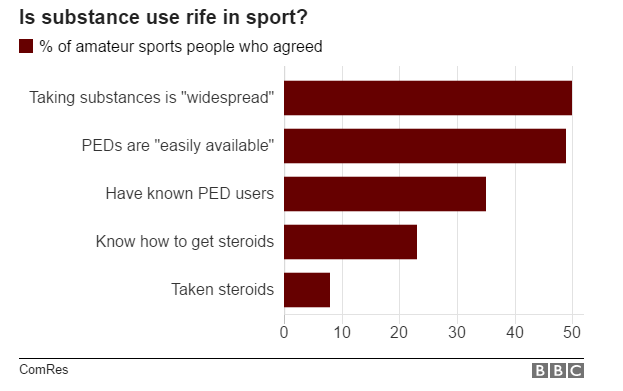Drugs in amateur sport is a growing problem
Many people who get involved in sport start out with dreams of stardom and riches. However, it is clear that only a very small percentage reach that level, meaning that the rest of us have to quickly reassess our goals. Despite the realization that for many of us the elite level is beyond our capabilities, we continue to pursue our chosen activity and are happy to compete at our own level. The sense of fun, camaraderie and vital exercise are other reasons why we continued to enjoy sport. There is an image of those who compete as leisure athletes as being quite happy to compete on a casual basis and that taking part trumps any notions of winning. However, that is clearly not the case as amateur sports can be highly competitive and no matter what level you are at, the desire to win can be as strong as any sports professional. There may be no financial reward or international fame, but being the best in your own race or region and the localized notoriety that brings can be enough motivation. Of course this is quite normal and healthy, but recent studies of amateur sport have identified cases where this can lead competitors to cross the line in their pursuit of success.

Study reveals widespread use of drugs
This win-at-all-costs mentality has led to a growing problem of drug use in amateur sport and is something that is highlighted in a UK Anti-Doping poll carried out by the BBC. The study conducted online interviews of 1,025 members of sports clubs, teams or gyms, in January 2017. The participants were representative of British adults over 18 years. The study revealed that:
- 26% of sports club members say they have previously consumed prescribed medications, such as Cortizone injections or asthma inhalers, to support their performance whilst playing sport
- 14% of sports club members say they have used recreational drugs for the same purpose, while 8% say they have used anabolic steroids
- A sizeable proportion of sports club report that performance enhancing drugs are frequently used, and easily available
- 35% of sports club members say they personally know someone who has used performance enhancing drugs to support their sporting performance or recovery

Results are incredibly alarming
The results of the report have been described as “incredibly alarming” by the UK Anti-doping (UKAD) chief at the time Nicole Sapstead, who added that it serves as a reminder of the challenges facing sport at all levels.
Certainly the figures as regards the prevalence of performance-enhancing substances at an amateur level are incredibly alarming. I think now is the time for everybody to sit up and acknowledge that this is a reality in every single sport and that you can’t just be washing your hands of it or hoping that someone else will address it
The extent of the problem is highlighted by Tom Cary in ‘Doping culture that is threatening to ruin British amateur sport could be worse than anyone realises’. In the article he lists some of the examples of doping in amateur sport on both sides of the Atlantic and they range from ‘Middle-Aged Man in Lycra’ who dopes to win a club race in front of one man and his dog to the 18-year-old on a semi-pro domestic team doping to win the junior national 10-mile TT. The report suggests that when it comes to gender there is little difference in terms of doping with 9% of men and 8% of women admitting to taking drugs. In terms of age, those between 18 and 34 (13%) were more likely to use steroids, than those aged between 35 and 54. However, those in the latter category were more likely to use substances for pain relief than for performance enhancement or recovery.
Why do amateur athletes take drugs?
Not surprisingly, amateur athletes take drugs in order to be successful, but according to Simon Usborne in Dope and glory: the rise of cheating in amateur sport, vanity is another reason, and this is manifested through the desire to look good physically and also to increase a positive public profile. In this way, “It’s sport as a public challenge rather than a private challenge”.
Another reason for the rise in doping in amateur sports is the easy access to drugs online and this fact is underlined by David Millar, the retired British professional road-racing cyclist, who became an anti-doping advocate when he returned from a two-year ban for
In the old days, you had to find out how to do it underground. Now anyone can hop on Google and get the same advice a team doctor used to get paid massive money for
Another reason for amateur athletes being tempted to use drugs is the fact that testing is very limited that that level and the chances of being caught are slim. It is clear that the issue is of concern but equally it is one that is difficult to tackle as Cary outlines.
With the ease of access to supplements and banned substances online, the growing gym culture, the obsession with the body beautiful, and the relative lack of testing at an amateur level
Cary reveals as he outlines that Nicole Sapstead admits the problem could be bigger than anyone realizes.
It’s very hard to quantify because most of what we are reading or hearing is anecdotal and unless you can start to build that picture with some credible evidence – whether that is from the athletes or the sports themselves, or whether the information is passed to us from law enforcement or the outcome of testing – I would be reluctant to say that it is a ‘growing’ issue
Enhance your athletic performance through knowledge
There are drugs for the mind and drugs for the body. Using or abusing either can be hazardous to your health. There is no need to risk harming yourself by taking banned or illegal substances. Share on X Just as you can alter your mind through meditation or simply absorbing yourself in a work of Art, you can enhance your athletic performance through knowledge: dedicating yourself 24/7 to a regime that involves constant self-monitoring of physical and psychological factors that are scientifically proven to affect athletic performance. Monitoring leads to data and insights, which lead to knowledge and power. By acting on this knowledge, you can optimize both your physical and psychological well-being, which will enhance your performance in both training and competition. Pushing yourself to peak levels of fitness in this way will give you an edge, and this edge will come at no cost to your physical health or your conscience.
If you are determined to win, don’t take the pill. Try Metrifit instead and empower yourself and your coach with knowledge and actionable intelligence which will truly enhance your game.
About Metrifit
Regardless of what monitoring tool or application you decide to use for your athletes and team, it is crucial that you understand why you are monitoring and how you are going to use the data to inform your decision making process. By monitoring key areas, coaches can help manage the 24-hour athlete and have a positive effect on athletic performance.
Successful change is about small steps in the right direction rather than giant leaps forward. Monitoring is key to getting the balance right. Share on X
Metrifit’s approach not only covers the physical requirements of a particular sport but also helps the coach derive the benefits of other factors that have a significant influence on an athlete’s well-being: training, body, nutrition, mind, and sleep. In this short video, we explain how Metrifit works for both the athlete and the coach.
To find out more contact us at or click on ‘Request Demo’ below.
Follow us on social media where we post regular blogs related to sports, performance and well-being.
References
Dope and glory: the rise of cheating in amateur sport by Simon Usborne
Doping in sport: Drug use ‘fast becoming a crisis’ – Nicole Sapstead
BBC SPORT AMATEUR SPORTS DOPING SURVEY
The fall and rise of David Millar
Drugs in Sport | Australian Academy of Science
Effects of Performance Enhancing Drugs | The United States Anti-Doping Agency
Adverse health consequences of performance-enhancing drugs | National Library of Medicine

 Previous Post
Previous Post Next Post
Next Post





